From Anne Lister and Sally Wainwright to Percy Shaw and the Piece Hall, Halifax is a town like no other


Halifax’s Street in the Sky is an echo of a time not too long ago, when stallholders lived – literally – above the shop. They worked in Borough Market, designed in a French Renaissance style by Halifax architects and brothers Joseph and John Leeming in 1896.
Behind the sturdy front doors the houses are spacious, three storeys high. Some still have beautiful period features and the light streams through dusty sash windows. They’re empty now, but the elegant, Grade 2* Listed market is a thriving, bustling place to meet and eat, with a wide range of stalls selling food and hardware, flowers and clothes, including the obligatory big knickers stall.
Advertisement
Hide AdAdvertisement
Hide AdBack in the day, one of the three market pubs, Portman & Pickles, was named after two of Halifax’s famous sons, the actor Eric Portman, probably best known for his roles in Powell and Pressburger films, and the broadcaster and comedian Wilfred Pickles.


Pickles was the first newsreader to speak in a regional accent and caused consternation by signing off “Good neet”. His first professional appearance was as an extra in a production of Julius Caesar at the Theatre Royal in Halifax in the 1920s. During the 1940s and into the 50s Eric Portman was one of the biggest stars of British cinema, ranking alongside other greats such as John Mills and Trevor Howard.
The story of Halifax can be told through the prism of its exceptional architecture, art and culture; but to understand the town today it’s worth remembering its brutal history. There’s no disputing that punishment in Halifax was harsh. The notorious Gibbet, a type of guillotine was used to behead 63 felons from 1286 to 1650, including thieves who took cloth from tenterhooks in Sowerby Bridge. If you escaped from the gibbet prior to execution and ran a mile you became a free man – The Running Man pub on Pellon Lane attests to this.
If Halifax was barbaric in the 1600s, it was positively Hogarthian in the 1950s: it was a town of four smells; smoke from hundreds of belching chimneys, hops from breweries, the sickly sweet smell of toffee from Mackintosh’s and the stench of rotting whale flesh from a pet food factory. It’s said the piles of meat were alive with rats at night. Ah the good old days.
Advertisement
Hide AdAdvertisement
Hide AdToday it looks and feels like a 21st century town; the extraordinary Piece Hall, the beating heart of Halifax has enjoyed a recent renaissance with a significant cash injection and two years of planning which has brought this former cloth hall back to dazzling life. In 1779, 315 merchants occupied trading rooms for just two hours on a Saturday morning, buying and selling bolts of worsted corduroy and the world famous Hebden Fustian.


It’s a unique building, and on a fine day it’s easy to imagine yourself in an Italian piazza, especially with an espresso or an artisan ice cream from one of the cool cafes in the square.
Just over the Victorian Gothic Revival North Bridge straddling the River Hebble is Dean Clough, a magnificent monument to the textile industry.
Built in the 1840s for carpet manufacturer John Crossley, by 1914 it was the biggest factory of its type in the world, employing 5,000 people. Sir Ernest Hall bought it in the 1980s and began an epic programme of renovation that his son Jeremy has continued.
Advertisement
Hide AdAdvertisement
Hide AdToday there are very different businesses, but there’s a palpable energy about the place. Alongside the Viaduct Theatre, Northern Broadsides and IOU Theatre are art galleries, coffee roasters, cafes and a number of bars and restaurants.
Halifax’s history of music is remarkable. In October 1959, Cliff Richard played the Halifax Odeon along with Gene Vincent and Billy Fury, and in November 1963 Dusty Springfield appeared for the opening night of her first solo tour here.
Promoter Michael Ainsworth booked the likes of Pulp in the Eighties, and since 2018, Elbow, Edwyn Collins and Embrace have played the Piece Hall, and booked for this year (fingers crossed) are the Manic Street Preachers, Richard Hawley, Kaiser Chiefs and Nile Rogers.
In May, Ainsworth is also due to co-host the Festival of Halifax, a celebration of the town’s cultural history, which will feature music, food, photography and film. No wonder a broadsheet journalist dubbed Halifax ‘The Shoreditch of the North’. I prefer to think of it as an urban Glastonbury, but with better toilet facilities.
Advertisement
Hide AdAdvertisement
Hide AdLocal lass Sally Wainwright has brought two outstanding series to our screens in recent years: Last Tango in Halifax, with a stellar cast including Sarah Lancashire, Sir Derek Jacobi and Anne Reid, and she told the story of Anne Lister with the phenomenally successful Gentleman Jack. Stunning Shibden Hall, a 600 year old timber framed manor house built in 1420 is a stone’s throw from the town centre and set in 90 acres of rolling parkland.
Built for the Lister family and occupied by them for generations, it was inherited by Anne in 1836. She became known for both her political activity and unconventional relationships; the actor Suranne Jones brought her to life with a great deal of style and wit, and a second series on the way.
There’s an embarrassment of architectural riches in Halifax, and it’s always worth looking up from shop fronts to see the facades of the original buildings. Somerset House on Rawson Street saw a remarkable facelift just over a decade ago.
Built in 1766 for merchant banker John Royd, it was designed by Wakefield architect John Carr, most famous for his work on Harewood House. Royd commissioned the York based Italian Rococo artist Guiseppe Cortese to decorate the ceilings in Tuscan-style and the beautiful, intricate stucco carvings have survived.
Advertisement
Hide AdAdvertisement
Hide AdHalifax’s ornate Grade 2* Listed town hall was designed by Charles Barry, who also designed the Houses of Parliament. The Holdsworth’s family history recalls the day in 1863 the Prince of Wales arrived to open the town hall: “There were amazing scenes in the decorated streets and in the Piece Hall. An estimated 100,000 people visited Halifax to join the celebrations.
The Lancashire and Yorkshire Railway put on a staggering 358 trains to Halifax on the two days of the Prince’s visit. As many as 70,000 tickets were issued from stations to Halifax on the first day alone. In the town, the crowds were watched by 870 police, 200 of them from London and others from Liverpool, Leeds, Sheffield and elsewhere.”
Haligonians have a special pride about their town, no better illustrated than in Alan Whicker’s 1968 documentary about cat’s eyes inventor Percy Shaw, who became a multi-millionaire but other than buying a Rolls-Royce Phantom didn’t let his fortune go to his head.
He lived for 86 years in a ramshackle house in Queensbury, and when Whicker asked him if he’d ever thought about living in London, he didn’t miss a beat: “Why would I? I’ve got everything I need right here.”